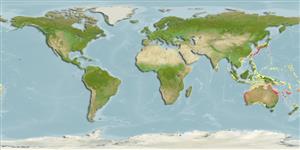Klassifizierung / Names
Namen | Synonyme | Catalog of Fishes(Gattung, Arten) | ITIS | CoL | WoRMS | Cloffa
>
Gobiiformes (Gobies) >
Gobiidae (Gobies) > Gobiinae
Etymology: Priolepis: Greek, prio = to saw + Greek,lepis = scale (Ref. 45335); akihitoi: Named for the Emperor of Japan, Akihito, for his significant and innovative contributions to the systematics of gobioid fishes..
More on authors: Hoese & Larson.
Environment: milieu / climate zone / depth range / distribution range
Ökologie
seewasser riff-verbunden; tiefenbereich 3 - 25 m (Ref. 85603). Subtropical
Verbreitung
Länder | FAO Gebiete | Ecosystems | Vorkommen | Point map | Einführungen | Faunafri
East Indo-West Pacific: Japan to Australia (WA to NSW), and New Caledonia.
Size / Gewicht / Alter
Maturity: Lm ? range ? - ? cm
Max length : 5.3 cm SL (female)
Kurzbeschreibung
Morphologie | Morphometrie
Rückenflossenstacheln (insgesamt): 7; Rückenflossenweichstrahlen (insgesamt): 10; Afterflossenstacheln 1; Afterflossenweichstrahlen: 8. This species is distinguished by the following characters: eyes slightly elevated resulting in a shallow pit in interorbital area and a shallow groove along dorsoposterior margin of eye; ctenoid scales completely covering predorsal, reaching to above mideye, anteriormost scales sometimes cycloid, no naked patch immediately before the first dorsal spine; small cycloid scales cover pectoral base; 11-13 rows of small cycloid scales cover prepelvic area; cheek usually no scales, rarely with 1 or 2 scales near dorsoposterior margin of preoperculum; operculum with a patch of small ctenoid scales dorsally; usually, D2 I,10, A I,8, pectoral rays 20; sensory papilla rows on cheek with transverse pattern; pelvic fins connected to form a plate, no interspinal membrane; head and body with narrow light bands, and with dark edges; a large elongate black spot anteriorly on first dorsal fin; 3-4 short vertical dark brown bars on dorsal part of caudal fin; mouth oblique, forming an angle of about 40°-45° with
body axis (Ref. 85603).
Life cycle and mating behavior
Geschlechtsreife | Fortpflanzung | Ablaichen | Eier | Fecundity | Larven
Hoese, D.F. and H.K. Larson, 2010. Description of two new species of the genus Priolepis from the Indo-Pacific with redescription of Priolepis profunda and Priolepis psygmophilia. Ichthyol. Res. 57(3):367-372. (Ref. 85603)
IUCN Rote Liste Status (Ref. 130435)
Bedrohung für Menschen
Harmless
Nutzung durch Menschen
Mehr Information
LänderFAO GebieteEcosystemsVorkommenEinführungenStocksÖkologieNahrungNahrungsorganismenNahrungsaufnahmeNahrungsmenge
NamenSynonymeMetabolismusRäuberÖkotoxikologieFortpflanzungGeschlechtsreifeAblaichenSpawning aggregationFecundityEierEientwicklung
Alter/GrößeWachstumLänge-GewichtLänge-LängeLängenhäufigkeitenMorphometrieMorphologieLarvenLarven Pop.Dyn.RekrutierungDichteBRUVS
ReferenzenAquakulturAquakultur ProfilZuchtlinienGenetikElectrophoresesVererbbarkeitKrankheitenVerarbeitungNutrientsMass conversion
PartnerBilderStamps, Coins Misc.LauteCiguateraGeschwindigkeitSchwimmstilKiemenoberflächeOtolithsGehirngrößeSehfähigkeit
Tools
Zusatzinformationen
Download XML
Internet Quellen
Estimates based on models
Preferred temperature (Ref.
123201): 20.1 - 26.7, mean 24.9 °C (based on 388 cells).
Phylogenetic diversity index (Ref.
82804): PD
50 = 0.5000 [Uniqueness, from 0.5 = low to 2.0 = high].
Bayesian length-weight: a=0.01023 (0.00477 - 0.02194), b=3.02 (2.84 - 3.20), in cm total length, based on LWR estimates for this (Sub)family-body shape (Ref.
93245).
Trophic level (Ref.
69278): 3.2 ±0.3 se; based on size and trophs of closest relatives
Widerstandsfähigkeit (Ref.
120179): hoch, Verdopplung der Population dauert weniger als 15 Monate. (Preliminary K or Fecundity.).
Fishing Vulnerability (Ref.
59153): Low vulnerability (10 of 100).
